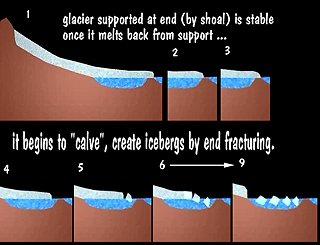Glaciers are not static bodies, they add mass at their head and lose mass at their ends. The relationship between addition and loss will determine if the glacier is static in size, if it grows over time, or if is shrinks over time.
Accumulation: when a glacier gains mass.
Ablation: when a glacier loses mass.
The excess or loss at the end of the year are called the mass balance.
The accumulation area is defined as the area that is still under some snow cover. The ablation area starts just below this. There is another demarcation line that can be placed on the glacier at the pint where the loss of material is equal to he gain of material.
This line changes from season to season and may move up or down the length of the glacier depending on the local conditions.
Net Gain in Mass
If a glacier is gaining mass over time then it will lengthen and the downward end (terminus) will advance further. If there is a loss in mass the terminus will retreat.
Size and Location
Measuring the advance or retreat may not be a real time measurement of the glacier condition. If the glacier is very large the yearly snowfall may have little effect on the terminus for several years. Or if the ice in a glacier moves very slowly, then the terminus will also show a lag in response.
For this reason, some glaciers (those that are small or have rapidly moving ice will often show fast season change, whereas those that are very large or very slow moving may not mirror the change for several years.

Calving
A fjord glacier may lose terminus by dropping large portions of its water bound terminus in the form of icebergs. Large masses of ice crash down into the water and drift away from the glacier terminus.
They key to calving is the underlying support, when a fjord glacier becomes undercut with water or the terminus moraine support fails, then the overhanging ice becomes unstable.
To regain stability the ice mass will lose fragments until the terminus is once again supported.
Glacier flow tends to be faster in the middle and slower along the edges as might be expected just from friction. The center portion of a glacier move under the pressure from the head area which causes ice deformation and creep.
The bed of the glacier is water lined in temperate glaciers but frozen in polar glaciers. Bed movement is improved by water in the contact zone. The movement due to differential stress is normally higher than the water contact zone.
As a result, glacier movement is not too dissimilar from the movement is a straight free flowing stream. Maximum velocity tend to be higher up and near the center, the slowest velocity is at the edges where it contacts the valley.
| NEXT | TOC | PREV |